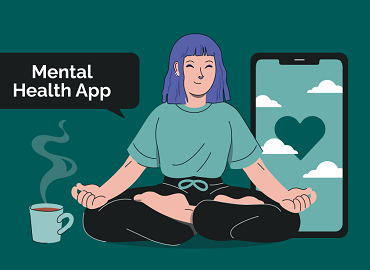Mental Health Tech: Developing Apps for Accessible Behavioral Health Solutions
By Larisa Albanians
Introduction
Mental health care is a critical yet underserved area of healthcare, with nearly 1 in 5 adults globally experiencing a mental health condition each year. Stigma, cost, and limited access to therapists often prevent people from seeking help. Mental health tech, particularly mobile apps, is breaking these barriers by offering accessible, scalable behavioral health solutions. This blog explores how developers are creating apps to revolutionize mental health care, making support available anytime, anywhere.
The Rise of Mental Health Apps in Mental Health Care
Mental health apps provide tools for managing conditions like anxiety, depression, PTSD, and stress. These apps range from guided meditation platforms like Calm to cognitive behavioral therapy (CBT)-based tools like Woebot. By leveraging smartphones, they deliver mental health care to users’ pockets, offering:
- Self-help resources: Guided exercises, mood tracking, and coping strategies.
- Therapist connections: Teletherapy platforms like BetterHelp link users with licensed professionals.
- Community support: Forums or peer-support features foster connection.
- Data-driven insights: Analytics to monitor progress, like mood trends over time.
In 2024, the global mental health app market was valued at over $4 billion, with millions downloading apps to access mental health care conveniently.
Why Mental Health Apps Matter
1. Expanding Access to Mental Health Care
Many people, especially in rural or underserved areas, lack access to therapists. Apps bridge this gap by providing 24/7 mental health care resources. For example, Talkspace connects users with therapists via text or video, eliminating the need for in-person visits.
2. Reducing Stigma
Apps offer discreet support, allowing users to seek mental health care privately. This is crucial for those hesitant to visit a clinic due to social stigma.
3. Affordability
Traditional therapy can cost $100-$200 per session. Apps like Headspace offer subscriptions for as low as $12.99/month, making mental health care more affordable.
4. Personalized Support
AI-powered apps analyze user inputs (e.g., journal entries) to tailor interventions. Woebot, for instance, uses chatbot technology to deliver CBT exercises based on a user’s emotional state.
5. Preventive Care
Apps promote daily mental wellness practices, like mindfulness or gratitude journaling, helping users build resilience before crises arise.
Key Considerations for Developing Mental Health Apps
Creating an effective mental health app requires careful planning to ensure usability, efficacy, and trust. Developers should focus on:
1. User-Centric Design
- Intuitive UX: Simple navigation and calming visuals encourage regular use.
- Accessibility: Features like text-to-speech or multilingual support cater to diverse users.
- Engagement: Gamification, such as streaks for daily meditation, boosts retention.
2. Evidence-Based Content
Incorporate proven methodologies like CBT, dialectical behavior therapy (DBT), or mindfulness. Collaborate with psychologists to ensure interventions are clinically sound. For example, Sanvello offers CBT exercises validated by mental health experts.
3. Data Privacy and Security
Mental health data is sensitive. Apps must comply with HIPAA (in the U.S.) or GDPR (in Europe) to protect user information. Use end-to-end encryption and transparent privacy policies to build trust.
4. AI and Personalization
Integrate AI to analyze user behavior and customize content. For instance, an app could suggest breathing exercises if a user reports high anxiety. However, balance AI with human oversight to avoid over-reliance on algorithms.
5. Integration with Healthcare Systems
Enable seamless data sharing with electronic health records (EHRs) or telehealth platforms to support coordinated mental health care. This ensures therapists can access app-generated insights, like mood logs.
6. Scalability
Design apps to handle growing user bases and diverse needs, from mild stress to severe depression. Cloud-based infrastructure and modular features support scalability.
Challenges in Mental Health App Development
Despite their potential, mental health apps face hurdles:
- Efficacy Concerns: Not all apps are backed by rigorous research, leading to skepticism about their impact.
- User Retention: Many users abandon apps after initial use. Engaging content and reminders are critical.
- Regulatory Compliance: Navigating HIPAA or FDA regulations can be complex and costly.
- Equity: Low-income users may lack access to smartphones or reliable internet, limiting reach.
- Over-Reliance Risk: Apps should complement, not replace, professional mental health care.
Developers can address these by prioritizing research, user feedback, and partnerships with healthcare providers.
The Future of Mental Health Tech
The future of mental health apps is bright, with emerging trends shaping their evolution:
- AI Advancements: More sophisticated AI will enable predictive analytics, like detecting early signs of a depressive episode.
- Wearable Integration: Combining apps with wearables (e.g., Fitbit) will track physiological data, like heart rate variability, to inform mental health care.
- VR and AR: Virtual reality therapy apps could simulate calming environments or exposure therapy for phobias.
- Policy Support: Governments are expanding telehealth reimbursement, boosting app adoption.
- Global Reach: Localization for non-English languages and culturally relevant content will broaden access to mental health care.
Conclusion
Mental health tech, through innovative apps, is transforming how we approach behavioral health. By expanding access, reducing stigma, and offering personalized mental health care, these apps empower millions to manage their well-being. Developers play a pivotal role by creating user-friendly, evidence-based, and secure solutions. As technology and policies evolve, mental health apps will become integral to global mental health care, ensuring support is just a tap away.

